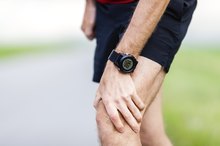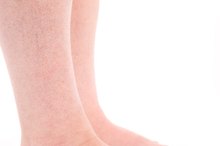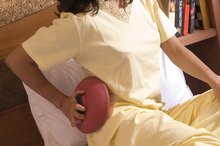Knee Pain While Running Downhill
Running routines sometimes bring more than just the benefits of a good workout and an endorphin rush. They may also bring knee pain, especially when you run downhill. It’s likely one of two common knee conditions. Don’t wait until the pain is so bad that you can’t run anymore. Seek treatment as soon as possible.
ITB Syndrome
Pain while running downhill is a classic symptom of iliotibial band syndrome, also known as ITB syndrome. It occurs when frequent flexing of the knee irritates the iliotibial band. The ITB is a thick, fibrous tissue that starts at the hip, runs the length of the leg and crosses over the knee. Inflammation feels like a dull ache initially and turns into a sharp knife pain across the knee cap. You’ll feel the pain more intensely when you run downhill and put pressure on the ITB.
- Pain while running downhill is a classic symptom of iliotibial band syndrome, also known as ITB syndrome.
- You’ll feel the pain more intensely when you run downhill and put pressure on the ITB.
Treating ITB Syndrome
What Causes Outer Knee Pain While Running?
Learn More
The first step in treating ITB syndrome is rest. Your doctor will want you to stop flexing your knee, ice it for 20 minutes at a time and use anti-inflammatory medication such as ibuprofen and cortisone shots. When the pain subsides enough to work with a physical therapist, you'll strengthen the muscles that support the ITB, such as the gluteus medius on your pelvis. Unfortunately, ITB syndrome is hard to treat. If conservative methods fail, you can have surgery to cut the ITB where it crosses the knee cap.
- The first step in treating ITB syndrome is rest.
- If conservative methods fail, you can have surgery to cut the ITB where it crosses the knee cap.
Runners Knee
Runners knee is another syndrome you feel intensely when you’re running down a hill. The official name is patellofemoral pain syndrome. This irritation is caused when the femur, the bone in your thigh, makes frequent contact with the patella in your knee cap. It presents as general knee pain that worsens with each step, especially as the femur makes more of an impact when you're going downhill. Runners knee is often the result of overuse.
- Runners knee is another syndrome you feel intensely when you’re running down a hill.
- It presents as general knee pain that worsens with each step, especially as the femur makes more of an impact when you're going downhill.
Treating Runners Knee
Knee Pain From Kicking a Ball
Learn More
Just like initial treatment for ITB syndrome, the key to treating runners knee is resting the knee, using anti-inflammatory medication and icing. This condition responds well to physical therapy. The focus is on strengthening your quadriceps in the front of your thigh. They will absorb more of the impact when you run and help stabilize the knee cap to keep it from moving too much. Surgery is a last resort and involves an arthroscopic procedure to smooth the underside of the knee cap.
- Just like initial treatment for ITB syndrome, the key to treating runners knee is resting the knee, using anti-inflammatory medication and icing.
Related Articles
References
- American Family Physician: Iliotibial Band Syndrome: A Common Source of Knee Pain
- Lespasio MJ, Piuzzi NS, Husni ME, Muschler GF, Guarino A, Mont MA. Knee Osteoarthritis: A Primer. Perm J. 2017;21:16-183. doi:10.7812/TPP/16-183
- Kiapour AM, Murray MM. Basic science of anterior cruciate ligament injury and repair. Bone Joint Res. 2014;3(2):20-31. doi:10.1302/2046-3758.32.2000241
- Doral MN, Bilge O, Huri G, Turhan E, Verdonk R. Modern treatment of meniscal tears. EFORT Open Rev. 2018;3(5):260-268. doi:10.1302/2058-5241.3.170067
- Reinking MF. CURRENT CONCEPTS IN THE TREATMENT OF PATELLAR TENDINOPATHY. Int J Sports Phys Ther. 2016;11(6):854-866.
- Petersen W, Rembitzki I, Liebau C. Patellofemoral pain in athletes. Open Access J Sports Med. 2017;8:143-154. doi:10.2147/OAJSM.S133406
- Frush TJ, Noyes FR. Baker's Cyst: Diagnostic and Surgical Considerations. Sports Health. 2015;7(4):359-65. doi:10.1177/1941738113520130
- Huang YC, Yeh WL. Endoscopic treatment of prepatellar bursitis. Int Orthop. 2011;35(3):355-8. doi:10.1007/s00264-010-1033-5
- Beals C, Flanigan D. A Review of Treatments for Iliotibial Band Syndrome in the Athletic Population. J Sports Med (Hindawi Publ Corp). 2013;2013:367169. doi:10.1155/2013/367169
- Tsai CH, Hsu CJ, Hung CH, Hsu HC. Primary traumatic patellar dislocation. J Orthop Surg Res. 2012;7:21. doi:10.1186/1749-799X-7-21
- Ragab G, Elshahaly M, Bardin T. Gout: An old disease in new perspective - A review. J Adv Res. 2017;8(5):495-511. doi:10.1016/j.jare.2017.04.008
- Lee PYF, Nixion A, Chandratreya A, Murray JM. Synovial Plica Syndrome of the Knee: A Commonly Overlooked Cause of Anterior Knee Pain. Surg J (N Y). 2017;3(1):e9-e16. doi:10.1055/s-0037-1598047
- Vaishya R, Azizi AT, Agarwal AK, Vijay V. Apophysitis of the Tibial Tuberosity (Osgood-Schlatter Disease): A Review. Cureus. 2016;8(9):e780. doi:10.7759/cureus.780
- Zanon G, Di vico G, Marullo M. Osteochondritis dissecans of the knee. Joints. 2014;2(1):29-36.
- Hindle P, Davidson E, Biant LC. Septic arthritis of the knee: the use and effect of antibiotics prior to diagnostic aspiration. Ann R Coll Surg Engl. 2012;94(5):351-5. doi:10.1308/003588412X13171221591015
- Gwinner C, Märdian S, Schwabe P, Schaser KD, Krapohl BD, Jung TM. Current concepts review: Fractures of the patella. GMS Interdiscip Plast Reconstr Surg DGPW. 2016;5:Doc01. doi:10.3205/iprs000080
- Voskuil R, Evenski AJ, Montgomery C, Emory CL. Malignant Bone Tumors of the Knee: How to Identify and Treat. J Knee Surg. 2019;32(4):305-314. doi:10.1055/s-0038-1675828
- Gupte C, St mart JP. The acute swollen knee: diagnosis and management. J R Soc Med. 2013;106(7):259-68. doi:10.1177/0141076813482831
- American Academy of Orthopedic Surgeons. Unstable Kneecap.
- Bhatia D, Bejarano T, Novo M. Current interventions in the management of knee osteoarthritis. Journal of Pharmacy & Bioallied Sciences 2013 Jan-Mar;5(1):30-38. doi:%2010.4103/0975-7406.106561
- Bronstein RD, Schaffer JC. Physical Examination of the Knee: Meniscus, Cartilage, and Patellofemoral Conditions. J Am Acad Orthop Surg. 2017 May;25(5):365-374.
- Browne K, Kurtz CA. How to perform a comprehensive examination of the knee. JAAPA. 2009 Jun;22(6):20-25.
- Hergenroeder AC, Harvey BS. (2017). Osteochondritis dissecans (OCD): Clinical manifestations and diagnosis. Bachur RG, ed. UpToDate. Waltham, MA: UpToDate Inc.
Writer Bio
James Roland started writing professionally in 1987. A former reporter and editor with the "Sarasota Herald-Tribune," he currently oversees such publications as the "Cleveland Clinic Heart Advisor" and UCLA's "Healthy Years." Roland earned his Bachelor of Science in journalism from the University of Oregon.








